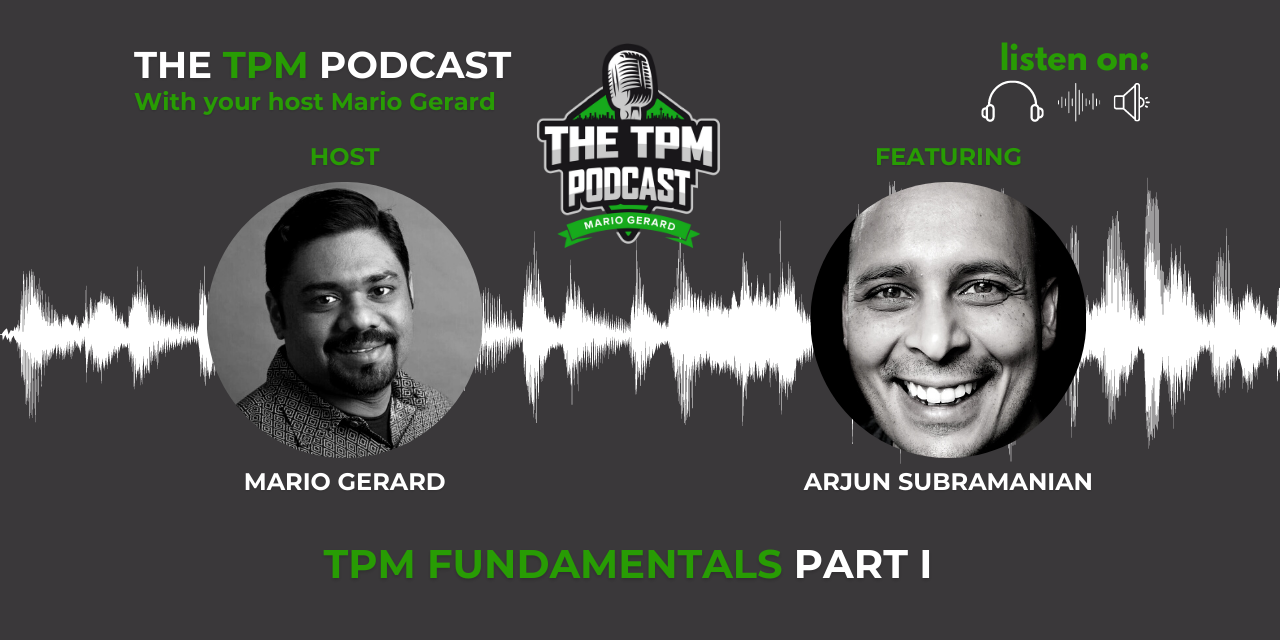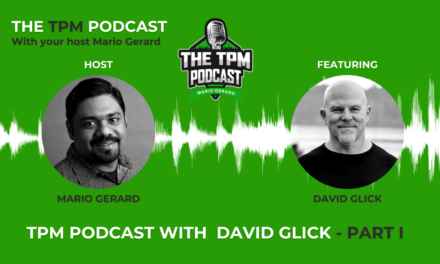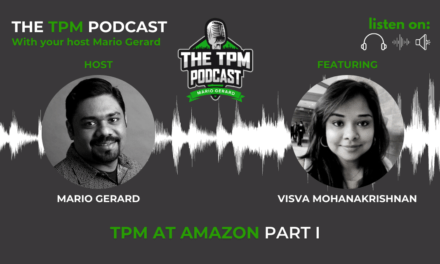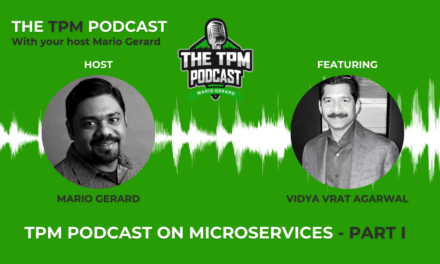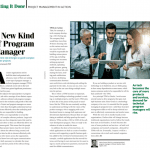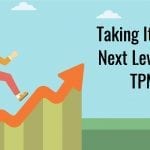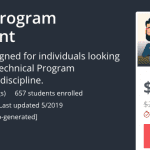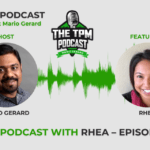Last updated on August 9th, 2024 at 09:55 am
Podcast: Play in new window | Download | Embed
Check out the podcast with Arjun Subramanian, he has worked at Appian, Amazon, Qualtrics and is now the Director of Product Management at Axon. Over the years he has been a Program Manager, Product Manager, and TPM.
In Part I of Episode I, we discuss the very fundamentals of what it takes to be a TPM, where a TPM would be most beneficial and so much more.
- Episode I – Part I (TPM Fundamentals)
- Episode I – Part II (TPM Fundamentals Continued)
- Episode II – Part I (Burnout)
- Episode II – Part II (Burnout)
Here is the transcript of the Podcast.
Mario Gerard: Hello and welcome to the TPM podcast with your host Mario Gerard. Today, we have a very special guest with us Arjun Subramaniam. He’s worked at Amazon, Qualtrics and is currently working as a product management, a director of product management at Axon.
Indroduction
He’s also been in a variety of different roles from being a program manager, a product manager, and a TPM. Arjun why don’t you introduce yourself.
Arjun Subramaniam: Hey, Mario. Thanks for having me on. My name is Arjun. I’m the director of product for axon foundation services. Axon is a software and connected devices company focused on the criminal justice system. We build software and most popularly known for body-worn cameras and tasers, it is a connected device. And the idea of.
For us to be able to modernize the justice system with the best technology. Axon foundation services AFS is the team I own. They are a platform team. We built all the primitives that you need in order to build cloud apps for the justice system. So, you can imagine how much Storage you would need full body worn camera footage. Cloud storage is a primitive.
So, we specialize in being able to store evidentiary media for really long periods of time, in a way that’s safe and recoverable. We own cartography and maps, which is another primitive for 911 dispatch and lots of other building blocks.
We call them Lego blocks for building cloud apps.
Mario Gerard: Cool. The company has significantly grown over the last, like four or five years, I think. Right?
Arjun Subramaniam: Yeah. Yeah. So initially the idea was just tasers. Small product company. The idea was to protect life and displace firearm uses. So, if you think about harm reduction as a strategy, you have all these different firearm uses by law enforcement or, or really anyone. And the idea is to obsolete firearms and provide a non-lethal or less lethal alternatives for firearms in dangerous situations.
From that one product, which became really, really successful we invented the body-worn camera which became then internet connected. And then if you ever watch footage of this stuff on TV you know you’ll see the Axon little golden triangle imprinted on the body-worn camera footage and that’s largely credited to the internet connected body-worn camera. And then now there are a fleet camera, and we have a suite of applications, cloud apps that are for different purposes and different actors in the justice system.
So, everything from like the patrol officers, to public prosecutors, public defenders, juries being able to orchestrate the flow of information for the entire justice system, not just the United States, but all over the world.
Program Manager vs Product Manager Role
Mario Gerard: Well, that’s fantastic. I think it’s a very interesting space and there’s a lot of good, interesting use cases there. That’s really interesting. So, I think today’s podcast is going to be really interesting because also because Arjun’s kind of worked as, as I said earlier, as a program manager, product manager and TPM, you’ve been a TPM at Amazon, probably for like 10 plus 12 years. And then now you’re kind of in the product role. So, I think we are going to talk about the differences between the two roles.
We’re also going to talk about how he switched between those two roles. And that’s going to be the first half of the podcast or the second half of the podcast, we’re going to focus more on a topic Arjun, and I care about deeply, which is burnout. So that’s how this is going to be split into like two different parts. So, let’s start with the first part, right. Arjun, why don’t you tell us in your opinion what does a TPM role mean to you?
Arjun Subramaniam: So, The TPM, technical program manager is a function that was kind of really grew up in technology companies.
Mario Gerard: I think it was Amazon, right? I don’t know, probably started it at the very beginning.
Arjun Subramaniam: It’s really hard to say. I think I’m certain this role existed even at Microsoft with the original program manager that they kind of created. At Amazon, As the company became more and more complex and you started having all these like engineering teams and product teams and cross-functional teams interacting with each other to build software products, you needed a kind of a, bandleader like someone who knew the drum beat, who own the plan, who understood technical strategy, who could kind of understand how engineering strategy and product strategy and the law and marketing strategy, all kind of work together in order to like, do something right, This cross-functional leader.
And so, during the execution portion of doing anything that’s hard the orchestration challenge became quite high. And so, the TPM role was created in order to manage the orchestration challenge. And part of it is a part program management, part technology, architecture, design, and part product role and different TPMs kind of, they come in like different kinds of flavours.
You know, it’s just like a martial art, you know, like some people specialize in certain things and some people, others, and some of it’s stylistic, temperamental, and, you know, it leans into one skill or the other. So yeah, that’s why it was created and to be an amazing TPM, you’ve got to have something amazing about your ability to execute. Okay. It’s a high leverage role. And what that means is that your presence on the team should 10X the capacity of that team compared to your absence.
Mario Gerard: I normally say it’s a force multiplier.
Arjun Subramaniam: That’s right. It’s a force multiplier. Right. And you’ll see, in many of these companies, you’re not going to have that many TPMS. And usually, the ratios you will see thrown an out are like one is to 10 or one is to 12 or something like that. And so, you’re outnumbered. And the whole idea is that your presence just force multiplies the impact of the team. So, at the broadest sense, TPM at every level has to show dramatic productivity and impact improvements to the team that, that person’s a part of, that’s how you do it.
Now, it comes in different flavours, and I’ve actually seen a wide variety of folks, both like people that are like incredibly technical, they could be principal engineers themselves, and then people that are not as technical also be really successful. And they all end up being forced multipliers and they all do different things. So, I don’t think there’s like one cotton dry persona or arch type of a TPM, but you’ve got to be able to show leverage. You got to be able to show that 10X impact on the team that you’re in.
Mario Gerard: Yeah. That’s a very interesting like core foundation block. When we talk about TPMs that they’re able to show that kind of an impact to the whatever scope they’re owning.
Arjun Subramaniam: Yeah. You know, one of the things that when I, when you got the teams that have really good TPMs, and you talk to different people in the teams. You’ll hear some common themes come out of it. One common theme is that wow! Like my life got easier because this people on the team. All right and you’ll see that come out in different ways, you talk to an engineer, and they’ll say like, wow! Yeah, of course.
You know, Mario was on the team. So, like my life got better in X, Y, and Z ways. And then you’ll often hear that thing got clearer because this person was around, what needed to be done, got clearer. It was much simpler than before this person was around. And these things like the simplifier, the provider of clarity, the accelerator, these are the ways your kind of can detect, you know, amazing TPM talent on the teams.
Mario Gerard: I put some engineers say. To do more of what I’m supposed to be doing, which is writing code, then go run around and get all these pieces of information or work on all of these other things. The amount of time I’m spending writing code is so little. And when somebody like this comes, I’m spending a large majority of my time, like writing and building new things.
Arjun Subramaniam: That’s right. That’s right.
PM roles at Amazon
Mario Gerard: So that’s a very good articulate way Arjun put that across. So, you’ve also, for a very short period. You’re a program manager, right? At Amazon. And then you moved to becoming a TPM. Can you tell us a little bit? The various program manager kind of roles at Amazon and what they normally do. I know you were there for a very short period.
Arjun Subramaniam: Yeah. So, I want to give some context. So, when I when I joined Amazon in 2007, so it was a very different company. It was a smaller company. Amazon grew a lot in the approximately 12 years that I was there. I did join as a program manager, but it was a calculated bet on my part. I went through the interview loops, and I didn’t get the technical designation because I wasn’t able to convince the technical interviewers on the loop that I was technical enough.
And I had other job offers but I decided that Amazon was the place I wanted to go to because I felt a lot of affinity to the loop. And I felt a lot of affinity to the company. Like I liked the first principles thinking I liked the customer obsession, the standards of excellence and rigor on things. I liked that.
So, I said, you know what, they’re not giving me the title I want, but I’m going to go there anyway. All right. And so, the strategy I followed was, look, they’re not convinced in a five-hour interview that I’m technical enough, but give me six months and I’ll convince them. So, I took the job and then the first thing I did when I joined the company, I had a chat with my manager and said, look I want to show you guys I am technical enough to do this, right. And so let me go at this. Let me go and get the opportunities that I need in order to like work with engineering teams and be credible. And so that’s what I did, for the first six months at Amazon that’s what I did. And at the end of that, they changed my title. And so, I got what I wanted.
That was my journey. That’s not the, I don’t think that’s the typical journey for a lot of people. And I think, though, you know, especially now Amazon has a much more structured People development and people management system. And so, there’s a lot more kind of…
Arjun Subramaniam: Delineation.
Mario Gerard: Yeah, there’s a lot more delineation and there’s almost structure and standards on what it means. So, with that context, I think, you know, if you are a program manager today, and you want it to be a technical program manager. The good news is, this is not anywhere by any means too far of a stretch, it’s on that spectrum of, you know, program manager, technical program manager, product manager, these jobs are on that spectrum.
So, the most important thing to show is that you can be credible with engineering teams. And if they, as in your management team or your leadership team, if they can trust a technically ambiguous problem and trust that you will drive solutions and simplifications that are technical in nature, that produce results and that you are able to show that, then you will be a TPM because that’s the difference, right? And the starting point is you know, instead of looking at problems that have a significant management complexity, right?
Like maybe like it’s a project management complexity or orchestration complexity, look for problems that are technically deep in their complexity. And when you find those problems, try to be useful in those situations and move yourself towards Business problems that have that right characteristic. And that builds your body of work. And then you can show the transition to technical program management.
Mario Gerard: I also did exactly what Arjun did. And I interviewed for a TPM role, didn’t get it, but they said, we like you. Why didn’t Join us as a program manager. So, if you look at my LinkedIn, you will see that I joined as a program manager and within like six months or eight months, they moved me to a TPM, right? Because in 5R window, it’s kind of hard to judge how technical you are, especially if you’re not that technical.
So always, there are a lot of, I think today there are a lot of smaller companies who would be willing to take a bet on you and to see like how technical you are, can you actually go and solve some technical problems. So, I think it’s a natural progression that you can always achieve.
Arjun Subramaniam: I will say this. In hindsight, there’s a temperamental quality that is entirely something you can learn, which is tenacity. And I think underneath the technical enough question, it’s really a question of, are you tenacious enough? Are you going to be creative enough? Are you going to take no for an answer when you run into an obstacle, right? Are you going to find the way in the obstacle? That’s the real skill.
And so, you know, I think the most important thing that I realized back then, I was really just learning to not give up on myself. You just have to like to beat an anxious and believe that you can solve the problems that need to be solved. And then you use your skills, your ability to pick things up, you learn things and then you get them done.
A Skill TPMs Must Have – Curiosity
Mario Gerard: Yeah. Another very interesting skill, which I feel TPMs must have in general, it’s curiosity. Supposing you’re in a room with engineers. You don’t understand what they’re talking about. You write things down, you go and you Google it, or you watch some YouTube videos. You don’t know what a queuing system means. That’s perfectly all right.
But then you go, and you follow up and you’re curious enough to go and learn all that. And I think that kind of catapults here, right? Because the next meeting you’re in where they’re talking about something like this is so well read that particular matter, [14:25 inaudible] kind of build expertise right?
Arjun Subramaniam: Yeah. And this is actually a really important point because this notion that you kind of have to like to build the knowledge base, that’s wide, it’s actually a superpower for TPMs, right? Because especially as you scale yourself up, right. And you’re going from a TPM, the senior TPM, the principal, the senior principal, and you’re doing this right. Cross domain expertise becomes like really, really important.
You have to be able to be in a variety of different functional areas and variety of domains. And that means that that general. Skills and stack that stack of capabilities to learn things that becomes really important.
Because even if it’s not technical, I guarantee you, you’re going to sit in a meeting with a room full of lawyers one day, and you’re not going to understand what they’re going to say, right. Or you’re going to go and sit with like, you know the marketing folks or the pricing folks or whatever it is.
And you’re going to have to figure out what’s going on. And so, it’s really important that you don’t get discouraged and that you follow that curiosity, like what you’re saying, and that’s a muscle, you just keep building it. You just don’t never take no for an answer.
Mario Gerard: Well, this reminds me of my time at Oracle where I probably as a principal TPM, I worked very closely with legal for some time, very closely with, at one point we were like shutting down an entire organization and I was working very closely with the social media team. So since like different skillsets, which you probably never thought you’d use, you’d have to like build that.
You have to be curious and you’re always dealing with the ambiguity factor, right? You very rarely walk into a room where you are the most knowledgeable person. So, you have to have the kind of curious nature and at the same time, be okay in a situation where you don’t know everything. You’re not an expert. And you kind of build that toolbox of qualities, knowledge, traits, and that kind of becomes your TPM kind of kit.
Arjun Subramaniam: Yeah. And you’re right. And then what’s going to happen is eventually we all realized that we are human and we’re unique and we all have different abilities. And then you’ll learn to appreciate that like, look, you’re really good at somethings, and those become your unique style of martial art for like, you know, going out and being really effective and being that force multiplier. But there is no other way, you just have to be tenacious and, you know, walk down that road.
How would you describe a product manager?
Mario Gerard: Yeah. And you wouldn’t know until you kind of try variety of these things. So, another question I had for you is since you’ve kind of been a TPM for like 10, 12 years, and now you’ve been in product for, I don’t know, like four years now, three to four years. How would you describe a product manager? Just basic, straight up question.
Arjun Subramaniam: Yeah. So, a product manager in my mind truly owns the entirety of the business need. All the way from discovering the need, All right. Driving clarity around what we need to do, what shouldn’t we do, doing the exploration with customers and really kind of like getting it to the point where like it’s real in the world, right?
The TPM is largely, is involved in those spaces, but you know, the TPM is kind of like a sous chef in that situation is not the head chef. The TPM is the head chef in the factory floor in my head. In the machinery of get things done. If you take like, hey, we know we have a really clear bullseye of what needs to be done, right? From a business point of view, right? The TPM is responsible for marshalling the entire resources of the company and nailing the bullseye, right?
The people, the Capitol, the consensus mechanisms within the organization, quite literally the TPM is the marshaller of internal resources of the firm to accomplish the business objective. However, if you look at it well, who understands the business objective, who understands the customer, who understands the trade-offs in the different ways in which we can go and serve a specific customer need. That’s going to be often the product manager, that’s taking the lead on that. All right. And the product manager, if you know, Is responsible in totality from the start to the finish of the product. Whereas the TPM is primarily responsible for getting it done within the firm. Marshall, the firm, Marshall, the army and all the resources to get it done.
Mario Gerard: It’s like the vision versus the execution.
Arjun Subramaniam: Yeah. And these lines of blurry because you can’t just say you’re not responsible for the execution, because you are like as a product man, you absolutely are. But if you look at who pays the different types, how do these people spend their time.
Mario Gerard: That is a very interesting way to look at it.
Arjun Subramaniam: Yeah. So, you know, the product manager is going to be spending a lot of time understanding the customer. The problem space, really fine-grained understanding of the customer problem, a deep heartbeat into what needs to be done, a clear bullseye for what needs to happen in order for the goals to be met, understanding the way to measure progress.
So, if you think about the product manager, they’re going to be very, very focused on that. And the product manager is also going to be focused on influencing the right people in the company towards the right things.
Mario Gerard: Like that’s so important, right? That’s a very significant portion of his or her job, like convincing the board, convincing the fellow product managers, convincing even the engineering leaders within the organization.
Arjun Subramaniam: Cause all you have is a soft power, right? So, you have to influence with what you have. You have to understand what the right thing to do is. And that means you have to have a whole set of skills to go understand that. And then you have to influence to be able to get people on board to go do that thing. But, if you look at what a TPM is going to be spending their time on, there’s going to be a ton of work, understanding the mechanics of how to get it done.
What is the right design choice? Who need to be involved? How’s it going to look if X, Y, and Z scenarios unfold versus some other set of scenarios unfold. How do the existing assets of the company like existing pieces of software, existing pieces of bodies of work that may exist, existing teams, how do they fit and contribute? So that, you know, the right set of things can happen in the company to get it done.
So, you can see it’s very much like, you know, it’s like, the field marshal is like, you know, setting the plan, but then there’s that person who is the general, right who is on the floor who was like, leading the troops. That’s kind of like the two models in my head.
Mario Gerard: Yeah. That makes a lot of sense. I also feel that the TPM and the Product manager are kind of Ying and yang, and they kind of work together, two sides of the same coin. Because one without the others kind of a failure, right?
Arjun Subramaniam: Yeah. For sure.
Mario Gerard: So, they’re fairly, they might be kind of opposing forces sometimes, because the product manager might want more things to be done. Maybe he’ll keep protecting his team. So, it could be like, it could be two different pieces to the same puzzle.
Arjun Subramaniam: Yeah, absolutely. I think that, like this tension is, it’s not just about the tension between products. This tension in any organization. All right. Because at any time this constraint, there’s tension, right. And there’s not, like anytime you have a system of constraints, you’ll have tensions between different stakeholders, different people, and all of that.
So, the organization of that tension forces is part of both people’s jobs. Like the product manager has to figure out you know, how can I make this product successful, not just in my head, in my imagination, in this rosy world, but how can I make it successful in the real world with the people I have, with the constraints I have. And how do I think about it not as a point, but as a vector.
Like if I think about not just like, you know, what am I going to do tomorrow, how am I going to take this year after year and I have a successful product arc, right. And that’s a different set of tension than like a TPM, that’s going to think about system tensions and stakeholder tensions and, you know, consensus within the company.
Does person B simply not care about this? Whereas this person is deeply passionate about making it happen this year. All of that operational tension is what the TPM has to unravel.
What are your favourite leadership principles?
Mario Gerard: That’s very well put. Let’s take a segue. Let’s talk a little bit about the leadership principles at Amazon and Since you were there for a significant amount of time, like, what are your favourite leadership principles? Like, I think you spoke about it a little earlier as well, right? What, leadership principles poke to you the most?
Arjun Subramaniam: So, I, I think obviously there’s, all of them have a role to play. But if I kind of had to pick one that attracted me to Amazon and probably still is near to my heart. It’s this idea of customer obsession, right? And this idea that, you kind of work back from what’s right for the customer. And a lot of that I think is what makes Amazon so special is that It’s so successful.
There’s a part of this as a TPM I think it really affected me. Because you realize that, you know, in this world of tension, right, you think about the system of constraints, like people wanting different things, systems doing things that may be in opposition to each other.
Customer obsession is actually a unifying principle if you think about it. And it helps you resolve tension. And one of the most effective ways to drive consensus in an organization is to convince people that their best interests are aligned. So, a huge part of, you know, connecting the dots on the what’s a rockstar TPM.
One thing that I look for in TPMS is can they actually drive consensus by helping stakeholders see where they have commonality and not where they have differences. And often TPMs will come to the table as the one person that could do that.
Mario Gerard: Who is that as an unbiased neutral party who can help things, who can take things forward.
Arjun Subramaniam: Right. So, I would say customer obsession is definitely one of my favourite ones and you can’t be successful without it. I actually think if it’s one export that Amazon has, just one export, if one idea, one principle went from Amazon to every other company in the world I would say it’s this one idea, which is put customers first. Okay.
And I don’t just mean that in like a mission statement. I mean like literally day-to-day. Like when you solve problems, start from the customer, work back. Understand the problems customers have, try to solve them.
Operationalize it in the way you work. And if literally like if Amazon was a product, the organization was a product and the one thing it did for the world was teach the world that this one principle is really powerful, and it can create a lot of value. It’s customer obsession.
That’s the one I would pick up. And I think for me, the way it affects me is, this notion that you need to find some unifying principle to work back from is actually like really powerful. You know that old expression, you know, if you don’t know where you’re going, any way will do.
And for a lot of folks, a lot of businesses, I don’t actually think without this unifying principle, they understand where they’re going. And so, a lot of it, you know, they get pulled by internal stakeholders, different agendas from like whoever is the loudest voice in the room or the most influential stakeholder, not what is good for the customer.
Mario Gerard: Good for the stakeholders, good for the shareholders. But not good for the customer. So, all of those endeavours are generally [27:53 inaudible].
Arjun Subramaniam: That’s right. That’s right.
Mario Gerard: Cool. That’s an interesting take. Let’s move on to a totally different topic on how you evaluate TPM candidates. What are the qualities you probably look for in TPM candidates and then we can probably also touch maybe a little bit on how do you evaluate the T in the technical program management rule?
Arjun Subramaniam: Yeah. Okay. So, I was a bar raiser at Amazon for many years.
Mario Gerard: You should also probably tell the listeners like in the early days
That you were at Amazon, how many TPMs approximately how many TPMs were there?
Arjun Subramaniam: So, you know, forgive me, I’m going by memory. So, it’s 12 years. So, you know, I might be off by a bit, but like there just aren’t that many, right. So, when I joined Amazon in 2007, I would say there is probably like double digit number of TPMs in the entire company. That includes all seniority levels. Less than 50, I’d say. So probably less than 50.
That was back in 2007, by the time You know, I got promoted three times at Amazon, and then I was, [29:09 inaudible] I think it was less than a hundred principals in the company. And the workforce was you know, approaching million, if not had hit a million at that time. I don’t know, somewhere in that range. And there’s probably a bigger number of [29:28 inaudible] there were only two senior staffs, senior principals in the entire company.
Mario Gerard: And even now I feel that’s very rare in most organizations.
Arjun Subramaniam: And especially of the scale of Amazon, you know, it’s just like, there’s just not that many. And if you looked at the pyramid of like, okay, how many, okay, so there were less than a hundred Principles, how many seniors were there? You know, maybe like a few hundred, like 500, 600 seniors, and then you have like a, you know, maybe like a thousand program managers, TPMs of like, of varying other sorts, right?
So, it’s not easy and it’s also just not that common. For many people you know, decide that they want to go do other roles. So, at varying inflection points in this ladder, some people decide they want to go be engineering managers. Some people decide they want to be product managers. And senior TPMs is a career position. So, you can stay there for the rest of your career. No problem.
Mario Gerard: And that my friends is the end of the first part of a two-part episode series with Arjun Subramaniam. Stay tuned for the second part. Hope you enjoyed that.

